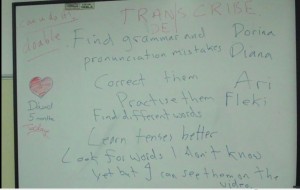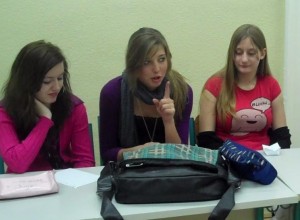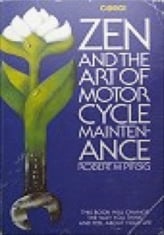After a year of blogging, exploration remains a key feature of “Classrooms on the Danube” and the framework of exploratory practice, as conceptualised by Dick Allwright and Judith Hanks, is still my preferred way of trying to understand what goes on in classrooms and also as a way of working with teachers in a non-threatening, stress-free environment.
Seeing classrooms from a fresh perspective
In Britain, over Christmas, I watched three BBC programmes called “Stargazing” which have rekindled my interest in astronomy, a subject I studied in my foundation year at Keele University. There is much similarity between looking at the universe afresh, marvelling at its beauty and its complexity and getting students to see classrooms afresh from a perspective that they are not used to seeing them from. This year, with the help of video technology, I’m going to try to get students to explore classrooms in new ways which I feel might have an impact on the way they define themselves as learners and the way they behave in classrooms. We’ll see!
As a person who works in an Applied Linguistics department, I’m always thinking about how the research findings of teaching and learning English conducted in a university and the lives of practising classroom teachers interact with each other. Everyone can benefit if there is are two-way, accessible channels of communication. Working closely with teacher associations and classroom teachers is one way of ensuring that this happens and organisations like IATEFL are places where space can be created for a fruitful dialogue to take place.
Exploration of classrooms at IATEFL 2011
I am delighted to to see that the IATEFL Learner Autonomy SIG at Brighton on Friday April 15th is going to spend some time at its pre-conference event on practitioner research and ways of doing it which rather than burdening and burning teachers out give people support and encouragement and inspiration to work together in collegial ways to understand their classrooms better.
Both Dick Allwright, my MA thesis superviser at Lancaster University, and Anne Burns, a leading figure in action research from Macquarie University, Australia are the invited speakers at the Learner Autonomy SIG event at the IATEFL conference in Brighton this year on Friday April 15th. I think this is a reflection of the close relationship between students taking on more responsibility for their own learning and teachers getting their students to research not only how they learn themselves but also the classroom culture in which classroom language learning takes place.
The aim of the event is to focus on how to get started and how to improve practice when developing learner autonomy at all levels of language teaching and learning. Learner autonomy is a key aspect of exploratory practice and is closely related to the fourth of Allwright and Hanks’s propositions of exploratory teaching. On my blog last year I worked on the first 3.
Learners are capable of independent decision making
Proposition 4: Learners are capable of independent decision-making
“Key Practitioners capable of taking learning seriously are not going to be always told precisely what to do, when to do it, how to do it and who to do it with. Unfortunately, though, many language classes around the world are like this. Language curricula, syllabuses, textbooks and lesson plans all tend to leave little space for learners to learn how to take their own, necessarily idiosyncratic, decisions about what to learn, when to learn it, how to learn it and so on. So, if learners never learn how, it is hardly surprising that teachers typically consider them to be incapable of taking independent decisions.”
Using the flip camera
Last year’s New Year’s resolution was to start a blog. This year it is to work with video in classrooms to understand classrooms better. I got a flipcam for Christmas off my Mum after reading about it on Jeremy Harmer’s, Jason Renshaw’s and Lindsay Clandfield’s blogs and decided to collect interesting moments in classrooms as well as to work with students on different ways of using video to improve understandings of the learning process and in turn improve language learning. I started this week.
This is a 1 minute moment from a class I taught on Tuesday after we had watched students videos and commentaries of their houses and flats which they had recorded at home on their mobile phones the day before. I asked them in groups to write down how this homework differed from their usual homework. I really liked this moment 5 minutes into the class when I had put everybody into threes to do the task and had four left and wanted to create two pairs instead of a group of 4.
I think working with these kinds of short edited clips with both teacher trainees, practising teachers and the students themselves to understand the classroom process may be very valuable in developing more reflective language teachers and more reflective learners. It was a moment where Dorina, the student, was not afraid to ask the teacher, me, about the how of learning and there may be a relationship between my willingness to take her suggestion on board and her future co-operation in the class.
The task the students had for homework was to transcribe the commentary of their videos and I elicited things which they could do with their transcriptions afterwards, these were the tasks they came up with on the whiteboard.

tasks which students came up with relating to transcripts of their own commentary of their own videos, filmed with their mobile phones
The basic principles of exploratory teaching
(1) Put ‘Quality of Life’ first
(2) Work towards understanding (not problem-solving or ‘improvement’)
(3) Work collegially (share with colleagues)
(4) Work inclusively (work to bring people together)
(5) Work for mutual development
(6) Put learning first, and make the research help the learning, and so avoid burn-out through overwork.
(7) Work towards a sustainable enterprise of learning, teaching and research.
Judith Hanks (2007)
I am particularly interested in exploring quality of life in the classroom and how little moments of negotiation like that small exchange with the girl in the video who didn’t want to be in a pair,for whatever reason,might enhance the quality of classroom life. I’d also like to talk with that group about that moment by showing that video in class within a broader activity about how students like or don’t like to be grouped in class and when certain ways of working might be more appropriate than others.
You might also work with stills from classroom life such as this one here where the girl in the middle, Ari, was trying to get other students to be quiet to listen to me giving instructions and the girl on the right then said “Shut up and pay attention”. This is another rich moment which could be analysed together with the students.
Making the familiar strange
Most students in classrooms have probably never done the kind of activity where a picture from their own classrooms is used to understand what is happening in lessons. I think the potential in these little tasks is enormous for increasing awareness of classroom life. We need to make the familiar strange and see classrooms fresh in the way in which the Apollo 8 crew saw the earth on Christmas Eve 1968, a year of much political turmoil; this picture became one of the most famous images in the history of the world and a picture of hope.
The Pale Blue Dot
There was a great conversation between the two astronauts when that photograph was taken which reminded me of the importance of working with what emerges in lessons instead of being tied too rigidly to over-planned lesson plans. Often over-preparing is worse than underpreparing and sometimes no preparing at all but a good idea and being in a state of being fully attentive to what is happening in the classroom is the best preparation of all. The joys of serendipity!
Borman: Oh my God! Look at that picture over there! Here’s the Earth coming up. Wow, is that pretty.
Anders: Hey, don’t take that, it’s not scheduled.
Borman: (laughing) You got a color film, Jim?
Anders: Hand me that roll of color quick, will you…
And maybe we can make the familiar strange even more in the way that this image did. It was sent back by the voyager spacecraft almost 4 billion miles away on Valentine’s Day 1990. It become known as the Pale Blue Dot in the words of Carl Sagan and it was his view that astronomy is a “humbling and character-building experience.” In his famous quote he went on to say “There is perhaps no better demonstration of the folly of human conceits than this distant image of our tiny world. To me, it underscores our responsibility to deal more kindly with one another, and to preserve and cherish the pale blue dot, the only home we’ve ever known.”
Maybe a similar anthropological humility is needed in our exploration of classrooms.
Quality of Life in the Classroom
There might be value too in considering classrooms not primarily as a place for transmission of knowledge or preparation for exams or rehearsing things that are then done later outside the classroom but as places where we experience quality of life much in the same way as we might experience quality of life with our friends, on holiday somewhere, drinking good wine or cooking good food.
Tuesday was the first time for over 10 years that I had been videoed teaching a class. Have been watching bits of it ever since and apart from making me want to have a hair cut and lose a bit of weight it really has been an eye-opener in looking closely at the way I relate to students and to the way in which students respond to me. Jeremy Harmer gave a great talk on this and there is a six-minute extract of it on youtube here:
Where to go from here?
I’ve been thinking about these things for a long time and we all have new ways of maintaining our interest in our professional lives, there are some fantastic examples of these on blogs and twitter and I’ve drawn enormous strength and encouragement from the ongoing discussion of our profession that I’ve been involved in over the past year. With the help of the little flipcam and subsequent work with the images it produces, I hope to deepen my understanding of classrooms in a way which makes me a better observer, a better listener and a better teacher.
Get filming and explore.
Exploration of classrooms will continue in many ways but if the students themselves can be involved in the process too then we will all benefit. Students have been doing this now for many years in Brazil in the exploratory teaching project, the results of which can be read in “The Developing Language Learner”, the book I mentioned at the beginning of this blogpost. I hope to involve students at our next IATEFL conference in Budapest in October in the same way that the young students have been presenting their work at conferences in Brazil.
And finally, in the words of Humphry Davy, the great scientist, chemist and inventor, probably best known for the Davy lamp to help miners work underground safely while surrounded by dangerous gases.
“Nothing is more fateful to the progress of the human mind than to presume our views of science are ultimate, that our triumphs are complete, that there are no mysteries in nature and that there are no new worlds to conquer.”
The same is true of teaching and classrooms!
And in the words of Ray Davies, lead singer of that great Sixties band from London the Kinks.
“This time tomorrow where will we be?
On a spaceship somewhere sailing across an empty sea
This time tomorrow what will we know?
Will we still be here watching an in-flight movie show?
I’ll leave the sun behind me and watch the clouds as they sadly pass me by
Seven miles below me I can see the world and it ain’t so big at all”





